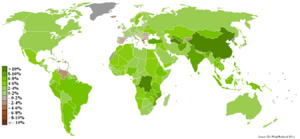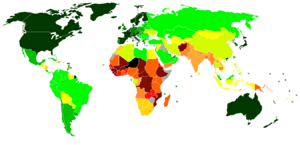Economic development facts for kids
Economic development is all about a country becoming better off. It's when people's standard of living improves, moving from a low-income (poorer) way of life to a high-income (richer) one. When the quality of life gets better for everyone, that's economic development happening.
When social scientists study this, they look at many things. They want to understand how countries have grown richer over time. They also study why some places attract more investment (money put into businesses) than others. And they try to figure out why people in some countries are better at creating and selling things.
Contents
How Do We Measure Economic Development?
|
0.950 and Over 0.900–0.949 0.850–0.899 0.800–0.849 0.750–0.799 |
0.700–0.749 0.650–0.699 0.600–0.649 0.550–0.599 0.500–0.549 |
0.450–0.499 0.400–0.449 0.350–0.399 under 0.350 not available |
Same map for people with color blindness.
One important way to measure economic development is through human development. This looks at how healthy people are and how good their education is. Usually, when people in a country become healthier and get better education, they also get richer. This is because healthy, educated workers are more productive (better at making things). Also, richer workers can afford good health care and education.
The Human Development Index (HDI) is a tool that measures human development. It looks at:
- How long people live (their life expectancy)
- How well people read (their literacy rate)
- How many people go to school
- How much money people make
Economists also look at the rate of growth. This tells us how fast a country is getting richer.
Economic Growth Around the World

Different parts of the world grow at different speeds.
North and South America
North America has steady economic growth. Many of the fastest-growing economies in this region are in the Caribbean.
South America often sees periods of fast growth followed by slower times, like in Brazil. However, growth has been more stable recently, and the whole continent is growing.
Africa
Africa has some of the fastest-growing countries, but also some of the slowest. For example, Angola has grown very fast because of oil. On the other hand, Zimbabwe has seen its economy shrink. Oil has created "wealth spots" where a few countries are much richer than their neighbors. In 2004, Equatorial Guinea's economy grew by 75% because of its oil reserves!
Europe
Europe usually has very stable economic growth. After the Soviet Union ended, countries in Eastern Europe faced economic challenges in the 1990s. But they recovered in the 2000s, especially those that joined the European Union. Many smaller European countries are growing much faster than their neighbors.
Asia and Oceania
In the 20th century, Asia was known for its rapid growth, especially China in the 21st century. Other parts of East and South Asia are also seeing strong growth. Countries with large populations often have high growth rates.
Oceania (like Australia and New Zealand) has moderate growth. One country with exceptional growth in Oceania has been Vanuatu.
Countries with Negative Growth
Some countries experience negative growth, meaning their economies are shrinking. This often happens because of ongoing wars or very high inflation (when prices rise very quickly). Examples include the Palestinian territories, Zimbabwe, Fiji, and Chad.
Besides these, economists also look at other things to measure development. These include total value of goods and services, how many people have jobs, and business information.
What Do Economic Developers Do?
Economic development is a special job that focuses on improving a community's economy. People who work in this field are called economic developers. They have two main jobs:
- They help create plans and rules for economic growth.
- They manage programs and projects that help the economy.
Economic developers often work for local or state governments. They also work for groups that are partly funded by public money. These groups, called Economic Development Organizations (EDOs), look for new business opportunities and help existing businesses stay strong.
Many other groups also work with economic developers. These include news companies, schools, hospitals, and universities.
There are over 20,000 professional economic developers worldwide. The International Economic Development Council (IEDC) is a non-profit group that helps these professionals do their jobs better. They also work to make the profession more recognized.
Communities, states, and even countries compete to attract new businesses. They offer things like tax breaks, money for investments, or free land to encourage businesses to move there. Economic developers help their communities compete and grow.
They also use tools to compare their community's strengths with others. They measure things like how many jobs are created, how much money businesses make, and how much tax money is collected. It's important to remember that economic developers don't usually create jobs themselves. Instead, they help businesses and new companies create jobs by setting up helpful programs and policies.
Related pages
- Developed country
- Developing country
- Development economics
- Human Development Index
- Newly industrialized country
- Least developed country
- OECD
- BRICS
- Next Eleven
- Four Asian Tigers
Images for kids
See also
 In Spanish: Desarrollo económico para niños
In Spanish: Desarrollo económico para niños



